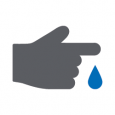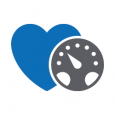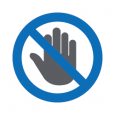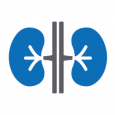Questions about your care? Worried about your health? We can help. Connect with our kidney experts on the phone and get your questions answered.
(But if you’re having a medical emergency, please dial 911.)
CONTACT USThey keep you healthy in a variety of ways, but the important thing to remember is their main job: to keep your body’s chemicals in balance. They do this by filtering waste and toxins out of your blood, and then creating the urine that will carry these wastes out of your system. All told, your kidneys filter about 120 quarts of blood and produce 1 to 2 quarts of urine every day.

Your kidneys aren’t just one big filter. Instead, that work is done by about 1 million microscopic parts called nephrons. The filtering part of the nephron, called the glomerulus, takes in blood and removes fluid and waste products from it. The glomerulus then passes the waste fluid on through the tubule, another part of the nephron. The tubule continues the filtering process by sending needed minerals back into circulation. What’s left after that is urine, which the tubule passes into the ureter, where it will travel into the bladder.
When your kidneys get damaged by disease, these parts can’t function like they should. This is called kidney failure. It can lead to a build up of toxins in your blood, which can be very dangerous. Unfortunately, there’s no turning back the clock on chronic kidney disease — it’s not possible to repair the damage done. That’s why it’s important to take very good care of your kidneys — or get dialysis or a transplant, if they’re damaged beyond repair.
But that doesn’t mean that there’s nothing you can do. No matter what stage of CKD you’re in, committing to your care can slow its progression, and keep your kidneys functioning as long as possible.
There’s no one cause of CKD — but in most cases, it’s related to diabetes and high blood pressure. Age plays a role as well; people over 60 are at an increased risk for it. Genes, too, are a factor, which may be part of why African Americans, Hispanics, and Native Americans are at the greatest risk for developing it.
CKD progresses in 5 stages, with stage 5 being the most severe. It entails near total failure of your kidneys and is otherwise known as end stage renal disease (ESRD). The symptoms of the early stages of CKD are very subtle and difficult to detect — so it’s important to get screened for it if you have any of the risk factors mentioned above.
And if the day comes when you do enter stage 5, you can seek dialysis or a kidney transplant to give yourself the best possible quality of life.
CKD can almost never be cured. But patients in the early stages of the disease can do a lot to slow this progression down. That’s why it’s important to understand how CKD affects your health. Getting tested, diagnosed, and treated early can add years of healthy kidney function to your life.
Each of CKD’s five stages are divided by how well your kidneys function. In the first three stages of CKD, symptoms are very subtle. You may not notice any physical changes at all. But if you have high blood pressure, or if you have irregular unrinalysis, your doctor may want to test for kidney problems.
The best measure of this is called the Glomerular Filtration Rate (GFR). Glomeruli are the tiny blood vessels that do most of the filtering work in your kidneys — so the GFR is measuring how well they do their job.
Your doctor can perform a blood test to find out what your estimated GFR (or eGFR) is.
A higher eGFR means better kidney function. Below, you can see the eGFR measures associated with each stage of CKD:
Every phase of chronic kidney disease comes with its own challenges. Thoughtfully managing your condition is the key to longer kidney health. Here’s how to approach each stage of the disease:
Minimal loss of kidney function (eGFR of 90 – 120)
This is the least severe stage of CKD. Your symptoms might be barely noticeable – if they’re present at all. If you’re diagnosed at this stage, it’s smart to focus on behaviors that can make a difference in your health:
Mild loss of kidney function (eGFR of 60-89)
This is mild to moderate loss of kidney function. As with Stage One, you may have a difficult time recognizing your symptoms. But that does not mean it’s unimportant to manage your condition. In this early phase, it’s especially important to be alert to any changes. Otherwise, steps of self-care are very similar to those for Stage One:
3a: Mild to moderate loss of kidney function (eGFR of 45 – 59)
3b: Moderate to severe loss of kidney function (eGFR of 30 – 44)
At this phase, it should become your goal to slow the progression of CKD. Discuss your options with your doctor, and as with other phases, do your best to maintain healthy habits:
Severe loss of kidney function (eGFR of 16 – 29)
It’s in Stage Four that the kidneys are truly beginning to fail. Symptoms will start to become more obvious, and include:
In this phase of CKD, you need to carefully consider how their everyday choices will affect their condition. Patients in Stage Four CKD will also most likely be candidates for either dialysis or a kidney transplant in the near future – you should talk with your doctor to see which might be the right choice for you.
Other steps to consider:
Kidney failure. Also known as end-stage renal disease, or ESRD (eGFR of 15 or less)
In Stage Five of CKD, your kidneys are only 10% as effective as healthy ones. This condition is also called end-stage renal disease (ESRD). The words “end stage,” in a medical diagnosis, can be frightening to see. Remember, though, that ‘end stage renal disease’ refers to the end of kidney function, not the end of your life!
The signs and symptoms of ESRD are similar to Stage Four CKD, but may be more severe, and they may come with new complications:
ESRD is quite serious. To stay alive, you will require either dialysis or a kidney transplant. But if you stick with your treatment regimen, and you’re careful about your body’s needs, you can continue to enjoy a full and active life.
Your priority should be to decide which treatment is best for you. Talk with your doctor to select one of these options:
With ESRD, following your treatment plan exactly will help you lead the fullest life you can. Pay attention to your clinicians, heed their advice, and seek support from family and friends.
At first, this diagnosis can feel like a catastrophe. ESRD demands a lot of adjustments. When they come all at once, they can make you feel like your life is over. It’s not. Even with ESRD, you can still work, travel, and keep up a social life.
At the same time, it’s normal for patients to feel a sense of grief when they learn about their diagnoses. Sometimes, along with the sadness, they have intense feelings of shame or guilt about their conditions.
If these feelings are overwhelming for you, consider seeing a mental health professional. They can show you how to take a constructive attitude toward your condition. That will help you lead a fuller, healthier life – even with chronic kidney disease.

However, the single biggest cause of kidney failure is diabetes. It causes almost half of all kidney failure in the US. If you’re diabetic, managing your disease can help prevent extensive kidney damage– but it may not stop the development of kidney disease.
You can read more about diabetes and kidney disease in our Diabetes section.

Hypertension, or high blood-pressure, is the second leading cause of kidney disease. Diabetes and hypertension share similar risk factors, like obesity, and unhealthy diet, and a lack of exercise. This means that the two ailments often come together — which can increase your risk for kidney disease.
But hypertension can be managed with healthy lifestyle choices. Your doctor and a dietitian can help you make a plan to keep your high blood-pressure under control.

Certain factors increase the odds of developing CKD. It’s important for you to understand how these factors affect you.
Some of them you can’t control. These are due to genetics, or traits like your age and race:

Other kidney disease risk factors are related to lifestyle. In many cases, if patients change their behavior, they can improve their kidney health. Some of these lifestyle factors are:

Finally, some diseases damage the kidneys or impair their function, leading to CKD. These include:

All the factors mentioned above increase the risk for kidney disease. But none of them guarantee that you’ll develop it.
It’s important to remember that, if you have any of these factors, you can take steps to decrease your risk. Monitoring your health, improving your lifestyle, and following your doctor’s advice will help you protect your kidneys.
Along with high blood pressure (hypertension), diabetes is the main cause of chronic kidney disease (CKD) in Americans. Almost half of all patients with CKD also have diabetes — and one in five people on dialysis have diabetic kidney disease.
However, most people with diabetes do not need dialysis. By properly managing your diabetes, you can prevent the damage that eventually leads to kidney disease. This means carefully monitoring your diet and your blood-sugar levels, staying active, and maintaining a healthy weight.
Diabetes affects your body’s ability to regulate blood sugar (glucose).
In patients with DKD, kidney disease leads to kidney scarring, which leaves them less able to filter waste out of the blood. Over time, this could ultimately lead to kidney failure.
More than likely, you will not notice any symptoms from early stages of diabetic kidney disease. Instead, the best way to check for it is through routine urine and blood tests.
Tests of your urine will examine its levels of albumin. Albumin is a protein that leaks into your urine from damaged kidneys. The higher the level of albumin, the more likely you have some kidney damage.
However, in later stages of kidney disease, the symptoms might be more serious. You should tell your doctor immediately if you notice fatigue, changes in your appetite, muscle cramps, swollen feet or ankles, or paleness in your skin.
Depending on the extent of the kidney damage, you may have a number of treatment options.
There are medications — like ACE inhibitors and Angiotensin Receptor Blockers (ARBs) — that can help protect your kidneys and heart.
However, if the damage is too severe, you may be a candidate for dialysis. If you’ve been diagnosed with DKD, discuss these options with your doctor.
 |
This is because the two ailments share similar risk factors — obesity, an unhealthy diet, and living a sedentary lifestyle. They also interact, each making the other more dangerous. Taken together, they dramatically increase a person’s risk for cardiovascular problems, like strokes and heart-attacks. The two ailments can seriously harm your kidneys. Diabetes and high blood pressure damage the arteries around the kidneys, which means that they won’t be able to deliver enough blood to the kidney for filtering. This is the start of a vicious cycle. While healthy kidneys produce hormones that help the body regulate blood pressure, damaged kidneys can’t. So high blood pressure damages kidneys, and damaged kidneys contribute to increased blood pressure. It’s a feedback loop that can get very dangerous. That’s why it’s so important to manage these conditions. If you’re at risk for either one, make sure you’re seeing your physician regularly, and do your best to pursue a healthy lifestyle, with a healthy diet. |
Metabolic syndrome is the name given to a collection of conditions related to obesity. When taken together, these conditions put you at increased risk for diabetes and heart disease.
 |
You may be diagnosed with metabolic syndrome if you have any two of the following:
|
See your doctor if you think any of these signs apply to you. Changing your lifestyle can help prevent some of metabolic syndrome’s more serious complications — especially if you catch it early.
Not all patients with metabolic syndrome will develop diabetes. But many patients with diabetes initially present with metabolic syndrome.
If your metabolic syndrome has advanced to diabetes, that may eventually compromise your kidney function — which might make you a candidate for dialysis.
PKD is an inherited illness, and is incurable. Although the disease mostly affects the kidneys, it also comes with complications — high blood pressure, loss of kidney function, liver cysts, complications in pregnancy, and brain
aneurysms are among the most severe.
Although the complications of PKD can be quite serious, changes to your lifestyle can minimize the damage done to your kidneys, and prevent some of PKD’s worst problems.
Electrolytes are elements and compounds that play important roles in your body’s functions. They’re present in your bodily fluids, and you also ingest them in food, drinks, and supplements.
The balance of electrolytes is maintained by several organs in your body — including your kidneys. Too much, or too little, of any of these electrolytes can lead to dangerous problems. It’s very important to treat them as soon as they arise.
Hemodialysis is a treatment option for electrolyte problems induced by kidney failure. Your doctor may decide this is the best course of action if the imbalance is serious enough.
Below are examples of electrolyte imbalances related to kidney disease.
CALCIUMCalcium plays an important part in the health of your bones, teeth, and blood vessels. Kidney disease and kidney failure can lead to an imbalance of calcium levels in your body. This can cause bone deformities and heart problems. See also: Mineral & Bone Disorders. |
|
CHLORIDEChloride works with other electrolytes to regulate the amount of fluid in your body. It also maintains a proper balance of acidity. Excess chloride is a possible complication of kidney failure. It can lead to changes in blood pressure and a narrowing of blood vessels around the kidneys. |
|
MAGNESIUMMagnesium is one of the most important minerals. It regulates some of your body’s most critical functions, including heart rhythm, muscle contraction, and nerve function. Excessive magnesium in the blood (called hypermagnesemia) is rare while the kidneys are functioning. But in end-stage kidney disease, hypermagnesemia can lead to very serious problems — including respiratory depression and abnormal electrical activity in the heart. |
|
POTASSIUMPotassium helps conduct nerve impulses, and regulates the flow of nutrients into and out of your body’s cells. Too much potassium can be triggered by kidney failure, and it could be fatal if left untreated. It can cause weakness, nausea, paralysis, and abnormal heart rhythms. |
|
SODIUMSodium helps maintain fluid balance in your body. It’s essential for many physiological functions. Kidney failure can lead to hyponatremia, which happens when your body retains too much water, relative to the amount of sodium. It’s a serious condition that can cause brain swelling, muscle spasms, and seizures. |
|
PHOSPHATEPhosphate closely interacts with calcium in your blood and is necessary for a variety of processes in your body. Kidney disease can lead to excess phosphate, which can cause itchiness, muscle cramps, joint pain, and rashes. |
Swelling in the legs, feet, and ankles—called edema—is not a specific disease. But, it can be a sign of kidney problems.
Healthy kidneys filter excess fluid from your blood, so you can pass it as part of your urine. When kidneys stop functioning well, this extra fluid stays in your body, and gravity tends to pool it around your lower legs (although sometimes it can also gather around your eyes).
Because kidney-related edema worsens as kidney function declines, patients on dialysis tend to experience edema frequently between procedures. While this kind of edema may look disturbing, it’s usually not dangerous.
However, if you’re experiencing pain alongside your swelling, or shortness of breath, it could be a sign that your edema is being caused by something else—like heart issues, cirrhosis, or deep-vein thrombosis.
Each of these is a serious medical emergency. If you have any of these symptoms, you should seek care immediately.
Kidney stones are salt and mineral deposits that form inside your kidneys. Although they initially take shape in the kidneys, they can affect any part of the urinary tract—from the kidneys, to the ureters, to the bladder.
There’s no single cause of a kidney stone, and they vary by which minerals compose them. But certain conditions—like diabetes, obestiy, and high blood pressure — may increase your risk for them. Prolonged dehydration, and a diet with excess sodium and protein, can also contribute.
Kidney stones are very difficult to detect until they’re large enough to cause symptoms. At that point they may shift into your ureter, and you’ll experience symptoms like pain in the lower back, abdomen, or groin; painful urination; pink, red, brown, cloudy, or foul-smelling urine; nausea and vomiting; and urinating unusually small amount.
Sometimes, the best course of action is to wait until you pass kidney stones through your urine. This can be very painful, but usually causes no lasting damage. Hydration and pain medication can help. Sometimes, however, they may require surgery.
If you suspect you have a kidney stone, consult your physician to determine the right treatment plan.
How Kidneys Affect Bone Health
In healthy people, kidneys contribute to bone health by keeping phosphorus and calcium in balance in the bloodstream. They do this in two ways:
What Happens When Kidneys Stop Working?
Kidneys impaired by disease, however, are less able to perform either of these processes. If damaged enough, they stop activating calcitriol, and they are less able to filter phosphorus.
This begins a phosphorus build-up, and the excess phosphorus saps calcium from bones, which weakens them.
Further, significant kidney damage causes your body’s parathyroid glands (pea-sized glands in your neck) to secrete parathyroid hormone. This hormone also draws calcium out of your bones. The whole process restores a healthy balance of calcium and phosphorus in your blood -- but it also makes your bones weaker.
What Can Kidney-Related Mineral Disorders Do to My Bones?
Some people call this kidney-related mineral disorder “The Silent Crippler,” as it can lead to bone deformities that can seriously compromise your mobility. It can also damage or impair blood vessels, which can cause heart problems.
In patients with chronic kidney disease, blood tests, a bone biopsy, or an X-ray are usually used to confirm mineral and bone disorders. If you have concerns about your bone health, you should ask your physician about these tests.
Treatment for mineral and bone disorders can involve modifying your diet to avoid phosphorus; taking supplements and medications to restore healthy hormonal function; and undergoing dialysis to control phosphorus levels in the blood.
What is Proteinuria?
An abnormal amount of protein in your urine is called proteinuria. It’s not an illness, but it could be a sign of one.
Temporary, or transient, proteinuria is usually not a serious concern. It can be brought about by stress, dehydration, or other factors. Pregnant women also tend to show higher levels of protein in their urine.
However, long-lasting chronic proteinuria is a sign of potentially dangerous dysfunction.
How is it Diagnosed and Treated?
Treatment for proteinuria depends on its underlying cause. That could be an excess of protein production in the body. More often, it’s an early sign of kidney disease.
Proteinuria could indicate that your kidney’s filters are not functioning as they should. They’re allowing excess protein to leak from your blood into your urine. This could mean that the kidney’s tissues have been damaged by disease.
You’re unlikely to notice proteinuria at home. (Although, sometimes protein-rich urine can appear frothy.) Instead, it’s usually detected with urine tests during a routine physical.
Diabetes and hypertension (high blood pressure) are both risk factors for proteinuria. Patients with these conditions should pay close attention to urinalysis results.
To prevent progressive damage to the kidneys, treating the root cause of proteinuria is very important. Options include dialysis, and medicines like Angiotensin Receptor Blockers (ARBs).
If you have proteinuria, consult your physician to see what treatment path is right for you.
Sticking to the right diet can keep your kidneys working better, for longer. Some small changes could add years of healthy kidney function to your life. As always, your doctor and dietitian can help you plan your diet. But there are four tips that can help everyone with chronic kidney disease:
Just like with protein, most Americans eat a lot of salt. Even with healthy kidneys, that’s not always a good idea. But with kidney disease, too much salt can cause some serious issues.
That’s because your kidneys are responsible for balancing the amount of sodium and water in your body. A sodium imbalance could cause you to bloat with excess fluid. It will also likely make you feel extremely thirsty, and drink even more fluid as a result! And, most seriously, it can lead to high blood-pressure.
Patients with chronic kidney disease should only eat 1,500mg of salt per day. That’s less than half of what the average American eats — so you’ll have to be careful.
Avoid fast food. Look for low-sodium products in the grocery store. And cook with lots of herbs and spices to make up for the missing salty flavor.
And one more important note — don’t use typical ‘salt substitutes.’ Most of them contain a lot of potassium, which, as you’ll see below, can also be a problem for folks with chronic kidney disease.
Similar to sodium, your kidneys keep the level of potassium balanced in your blood. But chronic kidney disease makes it harder for your kidneys to do this effectively.
Your body uses potassium to regulate your heart rhythm. Too much or too little of it can cause serious problems, like an irregular heartbeat, or even a heart attack. (See also: our section on electrolyte disorders.)
Since sick kidneys can’t balance your potassium for you, that means you’ll have to monitor your potassium intake yourself.
Talk to your dietitian about how much potassium you should be eating. For most patients with chronic kidney disease, this comes to about 2,000mg every day.
Your dietitian will also help direct you to the kinds of foods that are high and low in potassium.
Your body’s phosphorus levels need to be kept in careful balance with its calcium levels. Well-balanced phosphorus and calcium help keep your bones and heart healthy.
The work of balancing phosphorus and calcium is usually done by your kidneys. But sick kidneys struggle to keep that balance up.
If you take in too much phosphorus, it can leach calcium from your bones and strain your blood vessels. This puts you at risk for bone fractures and heart attacks.
Phosphorous pops up in lots of foods in the American diet. It’s popular in soft drinks, processed food, and fast foods.
Again, for people with healthy kidneys, these phosphorus-heavy foods aren’t too big of a deal. But for people with chronic kidney disease, they can be dangerous.
Perhaps the most important tip for avoiding phosphorous: stick to plain old water. Phosphorus appears in most sodas, iced-teas, soft drinks, and even sports drinks. H2O comes with none of these problems — and it’s almost always good for you.
It’s also smart to avoid fast food and processed meats. These are loaded with phosphates that help extend their shelf life. But they certainly won’t extend the life of your kidneys!
Talk to your dietitian to help you make smart decisions about your phosphorus intake. Their advice could make a big difference in your kidneys’ longevity.
Your dietitian will give you the best advice, and can work with you to come up with a diet plan that fits your needs. But there are some general guidelines that will always help.
During treatment, your body will lose a fair amount of protein. This means you’ll need to increase the amount of protein you get from your diet.
The best high-protein choices are whole, natural foods like beef, poultry, fish, eggs, lentils, tofu, and beans.
But be careful of overly processed meats or other protein sources. These can contain too much sodium and phosphorus (see below).
Each dialysis session will remove excess fluids from your body. But, if there’s too much liquid in your diet, dialysis won’t be able to do that effectively. This could lead to problems like heart strain, blood pressure changes, and fluid in the lungs.
This makes it important to count the ounces of fluids you take in every day. Your dietitian will let you know a safe daily total — it’s up to you to make sure you stay in healthy limits.
And you should be aware: many solid foods carry a lot of water. This is especially true for fruits and vegetables, such as tomatoes, grapes, melons, lettuce, and celery.
Every fluid ounce counts!
Potassium is extremely important in regulating your heartbeat. Healthy kidneys make sure your blood’s potassium levels are just right. But between hemodialysis sessions, your blood-potassium levels can spike if you’re not careful. This could lead to potentially fatal heart issues.
So watch out for potassium-rich foods. Bananas, tomatoes, dried fruit, and potatoes all carry a lot of potassium. Try to limit the quantity of these you consume between dialysis sessions.
Healthy kidneys keep your bones healthy by balancing the levels of phosphorus and calcium in your blood. But when the kidneys stop functioning, it’s easy for phosphorous levels to rise. This results in your bones leaching calcium — which can lead to weakness, fractures, and bone deformities.
Unfortunately, phosphorus is present in many protein-rich (or otherwise healthy) foods. Be careful, for instance, not to have too much milk, or peanut butter, or cocoa, or poultry.
Your dietitian will give you more details. And your physician may be able to give you medications that help you keep your phosphorus levels in balance.
For people on dialysis, sodium can cause problems because it makes them feel thirsty. This makes them drink too much fluid, which is not healthy during dialysis treatments.
It’s best to stick to fresh, naturally low-sodium foods, or buy low-sodium versions of prepared meals.
Salt substitutes often contain too much potassium, so it’s best to avoid them.
Instead, consult your dietitian to learn about healthier ways to make your food flavorful.
Since the treatment involves filling your abdomen with fluid, you may struggle with a sensation of feeling too full.
This may make it hard to get enough calories every day. Try to stick to the nutrition plan that you and your dietitian agree to — even if you have to eat through a little discomfort.
But your diet should never cause you excess pain! The goal is to feel healthy and energetic.
Pay attention to how you feel after you eat, talk to your doctor or your dietitian about it, and make changes as they’re called for.

Questions about your care? Worried about your health? We can help. Connect with our kidney experts on the phone and get your questions answered.
(But if you’re having a medical emergency, please dial 911.)
CONTACT US